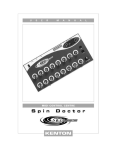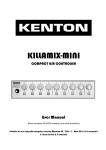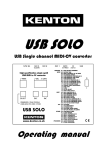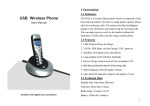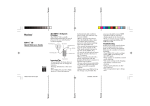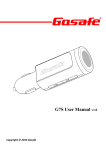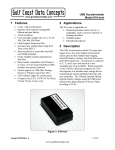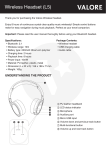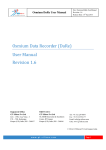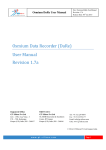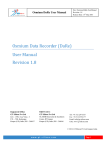Download MidiStream Manual (Acrobat File 88Kb)
Transcript
MidiStream UHF Wireless MIDI System Operating Manual Introduction Congratulations on your purchase of the MidiStream UHF wireless MIDI system. The MidiStream system is very easy to use, but please take a few moments to read through the manual to avoid any operational difficulties. MidiStream has been designed specifically to address the problems unique to MIDI data transfer. It combines a high data rate with extremely low latency and low dropout rate. Should dropouts occur due to going out of range or interference from other sources, MidiStream is designed to handle these events without leaving notes stuck on. The MidiStream system works in the 868 to 870MHz pan European licence free band. At the present it is available with one frequency of 869.85MHz which means that you cannot use two MidiStream units close to one another, however we plan to make other frequencies available in the future to enable multiple units to be used in the same vicinity. About the Transmitter Unit MIDI In socket Connect your keyboard, wind controller or other MIDI device to this input socket using a standard MIDI cable. Antenna The antenna fitted on the MidiStream transmitter is not removable, do not attempt to unscrew it! Try to ensure that the antenna is straight when operational and if possible is placed away from other solid objects, particularly metal ones. On/Off switch When this switch is on, the MidiStream transmitter is operational and waiting for MIDI data. LED This LED has four functions: 1) The LED will give a steady glow when the MidiStream transmitter is on, 2) When MIDI data is received the led will flicker in response to the incoming MIDI signal. 3) If the battery voltage is low (6.5 volts or less), this LED will flash regularly on and off 4) If the unit enters power save state, the led will blink briefly every two seconds Changing the battery: When the LED indicates that the battery voltage is low, it is time to change the battery. Unscrew the knurled knob on the bottom of the unit and open the flap. Turn the unit so that the battery falls out under it’s own weight, but try to catch it so as not to stress the connecting wires. If the battery voltage falls below about 4.5 volts the MidiStream transmitter will no longer work. About the Receiver Unit Power on/off switch Push this switch IN to turn the unit on. DC IN 9-12V Plug the supplied power adapter into here. The unit will take an adapter with an output in the range of 9-12V either regulated or unregulated. The socket is a 2.1mm type with centre positive. Do not use an adaptor with an output voltage higher than 12V, and the MidiStream must not share an adaptor with any other device. Failure to observe this will invalidate your warranty, and will probably damage the other device, the MidiStream and/or the power supply. 2 MIDI Out This output gives a copy of the MIDI data which was sent to the transmitter. Connect a MIDI lead from here to the MIDI In of your sound module, computer or other MIDI equipment Antennas A & B The MidiStream receiver is what is known as a diversity system. This means that it has two complete receivers, each with their own antenna, plus a system which arbitrates between the two incoming data streams, so that if one antenna is not receiving the signal from the transmitter, the chances are that the other one will be. The antenna connections are via BNC type connectors. To attach the supplied antennas, push them onto the BNC plugs attached to the MidiStream receiver and then turn the knurled outer ring clockwise until a click is felt. Ensure that when operating the MidiStream receiver, the antennas have as much free space around them as possible, preferably keeping them away from metal objects. It is suggested that, rather than mounting the MidiStream receiver inside a rack system, the receiver is placed on top of the rack during operation. If the MidiStream receiver must be mounted in a rack, then external antennas must be used and placed on top of the rack, or other suitable place away from interference sources, during operation. Under no circumstances should the antennas be inside the rack, even with the receiver turned back to front, as reception will still be severely impaired due to reflections from other metalwork and the general high background noise level typical of a rack. Status LEDs MidiStream has four status LEDs which have the following functions: ON MIDI RF-A RF-B (Blue) (Orange) (Green) (Green) Indicates that power is on. Flashing means transmitter battery is low. Indicates that MIDI data is being received. Indicates that valid data is being received by Antenna A Indicates that valid data is being received by Antenna B Ideally both RF-A and RF-B should be constantly lit while the transmitter unit is on. Try to position the receiver where you get RF-A and B lit constantly in normal operation. Don’t worry too much about the occasional flicker of one or other, but if both go out at the same time, you have lost your link. If the transmitter is turned off (or power save is active) then the RF-A and B LEDs will go out. Getting the best out of the MidiStream system Optimal placing of the receiver and transmitter Ideally aim for line-of-sight communication between transmitter and receiver. Try and get the receiver as high as reasonably possible (put it on top of your rack, not in it) and away from other objects, particularly metal ones. If you can keep the transmitter away from your body, so much the better, ideally mount the transmitter on your instrument or carry strap. Range The MidiStream system has a range of up to 100 metres in open space or about 30 metres indoors, although this can be reduced by solid objects in the way. As the receiver uses BNC connectors for the antennas, you can use external / remote antennas if circumstances require. Speak to Kenton if you want to do this as we can advise. Using in a rack system Don’t mount the MidiStream receiver inside a rack unless you use antennas placed outside the rack. Kenton can advise on suitable antennas for use with a rack mounted receiver. Kenton intend to produce a rackmount kit for the receiver in the future, which will include suitable external antennas. 3 Exposure to radio frequency energy and potential harmful effects The transmitter operates at an extremely low power of 5 milliwatts or less, (somewhat less than a typical mobile phone) however you should be aware that the effects of radio frequency energy on the human body are not fully known at this time and exposure should be minimised wherever possible. As mentioned above, if you can keep the transmitter away from your body, so much the better. Rechargeable batteries You may find it more economical to use rechargeable batteries in the transmitter. Kenton recommend that you have two rechargeable batteries, one inside the transmitter, and one on charge. Kenton can supply high capacity rechargeable batteries and chargers suitable for use with the MidiStream transmitter. The rechargeable batteries we supply have a capacity of 250mAH (most are 150mAH) which means that you can operate the transmitter for about 5 hours continuously on one charge. Contact us for more details. Power save mode If the system is likely to be used in a situation where there are long idle times between MIDI messages (many minutes), you can enable power save mode in the transmitter to increase battery life. To control power save mode, you need to send one of the following SysEx messages to the transmitter : To enable power save mode and set timeout, send To disable power save mode (always on), send F0 00 20 13 0B 00 00 TT F7 F0 00 20 13 0B 00 00 00 F7 Where the strings given above are in hexadecimal and TT is the time in minutes before the unit turns itself off – values 1 to 127 minutes are valid times until turn off, and 0 means the unit stays on all the time. TT must never be more than 127 decimal (7Fh). For example F0 00 20 13 0B 00 00 3C F7 will set the timeout to 60 minutes (3C is the hexadecimal representation of 60). See the next page for more examples and a decimal to hex conversion chart. Any setting is stored in non-volatile memory, factory default value is ‘always on’) When power save mode is enabled, the transmitter will stop transmitting RF (radio frequency) if no MIDI message has been received for a pre-determined time (set as TT above). You will know that the transmitter has stopped because the two LEDs, RF-A and RF-B on the receiver, will go out and the led on the transmitter unit will blink briefly every two seconds. As soon as a new MIDI message is received the transmitter will turn back on, but be aware that the turn-on and re-synchronisation process takes a few milliseconds so the first message will be delayed very slightly, although probably not noticeably. Although the unit uses less power when the transmitter is stopped, it doesn’t reduce power consumption to zero. Typically power consumption is reduced to one third of normal when the transmitter RF section is shut down. Power consumption is only reduced when the timeout has occurred and the RF section has shut down, otherwise power consumption is normal. For the unit to shut down the transmitter RF section in power save mode, it must receive no MIDI messages of any kind during the timeout period. If your MIDI instrument constantly sends active sensing messages then the transmitter RF section will never shut down and no power will be saved. Uses for the MidiStream system Although the MidiStream system was originally designed with instruments such as the AX-1 in mind, many other uses have been suggested since. The main other instruments are wind controllers such as the WX-5 and MIDI accordions. As well as those uses, MidiStream can be used in theatres or other venues to couple a front-of-house MIDI sound or lighting desk to slave units on stage. MIDI throughput MidiStream has a very low latency and high MIDI throughput. It handles all MIDI messages including Clock and SysEx messages, however, try to avoid very large SysEx dumps (1k or more). If you need to send very large dumps, try to split them up into blocks with a few milliseconds between each block. MIDIOX can do this. MIDIOX is an extremely useful utility and you can download it for free from www.midiox.com 4 Note hangs & controller updates MidiStream has been especially designed to make note hangs extremely unlikely. If you go out of range of the receiver or the signal gets interrupted, all current notes will be turned off. When the transmitter is back in range, the current value for major controllers, such as MIDI volume, modulation wheel, pitch-bend, breath control & program change will be re-synchronised with the most recent values which were sent to the transmitter. Notes however will not be turned back on again. More about power save mode Example strings for a selection of times 5 minutes 10 minutes 15 minutes 20 minutes 25 minutes 30 minutes 40 minutes 50 minutes 60 minutes 70 minutes 80 minutes 90 minutes 100 minutes 110 minutes 120 minutes 127 minutes F0 00 20 13 0B 00 00 05 F7 F0 00 20 13 0B 00 00 0A F7 F0 00 20 13 0B 00 00 0F F7 F0 00 20 13 0B 00 00 14 F7 F0 00 20 13 0B 00 00 19 F7 F0 00 20 13 0B 00 00 1E F7 F0 00 20 13 0B 00 00 28 F7 F0 00 20 13 0B 00 00 32 F7 F0 00 20 13 0B 00 00 3C F7 F0 00 20 13 0B 00 00 46 F7 F0 00 20 13 0B 00 00 50 F7 F0 00 20 13 0B 00 00 5A F7 F0 00 20 13 0B 00 00 64 F7 F0 00 20 13 0B 00 00 6E F7 F0 00 20 13 0B 00 00 78 F7 F0 00 20 13 0B 00 00 7F F7 maximum timeout period permissible Always on F0 00 20 13 0B 00 00 00 F7 never times out Decimal to Hex conversion chart Decimal 0 1 2 3 4 5 6 7 8 9 10 11 12 13 14 15 16 17 Hex 00 01 02 03 04 05 06 07 08 09 0A 0B 0C 0D 0E 0F 10 11 numbers then continues in a similar fashion etc. 5 Details of the MidiStream SysEx messages SysEx messages exclusive to the MidiStream system are made up as follows: [1] [2] [3] [4] [5] [6] [7] [8] F0 00 20 13 0B aa dd F7 - Begin SysEx command - Company ident first byte - Company ident second byte - Company ident third byte - Product code – MidiStream System - Address byte – where address 00 is for setting timeout (no other addresses valid at this time) - Data byte – where data values of 00 – 7Fh (0 – 127 decimal) are valid values - End of SysEx 6 Transmitter Specifications Power 9 volt battery. PP3 type (also known as 6F22 or MN1604 or S-006P) Power consumption Typically 55mA in normal use or 17mA when power saving Battery life 4 – 5 hours with a full battery. Transmit frequency 869.85MHz MIDI In only LED Indicates power on, low battery, power save & MIDI activity Weight 285 grams Dimensions 100 x 70 x 30 mm (not including antenna) Non-volatile memory EEPROM (no back-up battery required) Receiver Specifications Power Input 9-12V DC 120mA, 2.1mm plug centre +ve (Mains adaptor supplied) Receive frequency 869.85MHz MIDI Out only Display Four status LEDs indicate Power on (TX low batt), MIDI, RF-A & RF-B Weight Receiver 850 grams – Power adaptor 300 grams Dimensions 241 x 115 x 32 mm (not including antennas) Non-volatile memory EEPROM (no back-up battery required) WARRANTY MidiStream comes with a 12 month (from purchase date) back to base warranty, (i.e. customer must arrange and pay for carriage to and from Kenton Electronics). Brookfarm House, Station Road, South Wimbledon, London, SW19 2LP, UK Tel: +44 (0)20 8544 9200 Fax: +44 (0)20 8544 9300 e-mail:[email protected] www.kentonuk.com rev# 1116 e. & o. e. 17 December 2003 th 7







